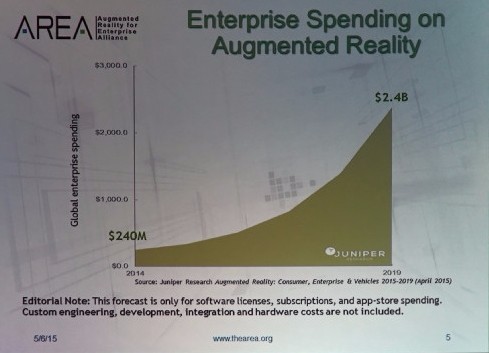We moved to the AR for Enterprise track where where he heard that the Augmented Reality for Enterprise Alliance (AREA) is a trade association that is supporting the development of professional and corporate applications of AR/VR. Its main aim is to drive the expansion of the application and it wants to be a global, member-based organisation. There has been a lot of hype, and expectations don’t always match what can be done. www.theAREA.org
Infrastructure companies can really exploit A/R, because small increments to efficiency can make a big difference. The group also plans to include display industry companies (although there are none yet in the group, but it’s only one month old).
The next speaker started by showing a video from Microsoft about how the Hololens technology can be used in architecture to allow realtime interaction.
He made the point that you can’t have effective AR without enterprise data – so that information is real time. Customers are looking for faster response and to reduce the time spent on tasks. Enterprises want to make better use of experts. Key benefits are to reduce errors. Another factor that is compelling for enterprises is real time compliance – that is to say checking that what should be done has actually been done. Enterprises also always want to reduce cost.
 Juniper has made a big growth forecast of $2.4 billion by 2019 for the A/R market and the point that was made was that the chart was for software licences only – hardware, application development and service are on top.
Juniper has made a big growth forecast of $2.4 billion by 2019 for the A/R market and the point that was made was that the chart was for software licences only – hardware, application development and service are on top.
Those that want to introduce A/R have a lot of education to do, as there is still a lot of misunderstanding about how AR/VR can work
The next speaker was Jay Kim from APX Labs who has been working on A/R for the last four years.
New technology in the enterprise goes through a standard set of processes and A/R has to go through those. e.g. if you have mobile devices, you need a support structure for the devices to make sure they are secured and charged and there are lots of issues in security and firewalls. The process can be a real barrier to developing applications quickly. That’s a factor you have to think about when planning a project.
There are security issues – mobile devices can “walk” – what if they have trade secrets, Kim asked? It’s not just an app, you have to support over time and provide, for example, training. Although function is key, comfort and even fashion can influence use, even in the enterprise.
Kim said that at the moment, hands free applications are the important ones. Assisted Reality is a good phrase, and Kim said that apps should be like Hololens – just in time microinteractions e.g. giving users diagrams and other data from enterprise. The key is to find “ready to harvest” information from pre-existing data residing in ERP. He said that this typically consisted of text, diagrams and workflows often in .pdf format documents. The most successful projects are those that succeed in delivering this kind of data to users.
For headsets, batteries capable of supporting 8-10 hour use are essential. It also helps when apps can help to bridge a big difference between experts and novices. Kim said that smart safety glasses are a big market at the moment.
AREA members have done a lot of small “sandbox” applications, but everybody now wants to roll them out in some scale.
Kim then showed how his company’s Skylight technology delivers content.

